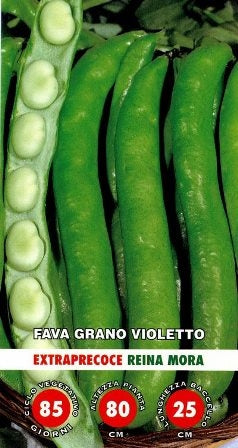The broad bean (Vicia faba or faba vulgaris) is a papilionaceous legume, known and cultivated since ancient times in the Mediterranean basin and in the Middle Eastern area as food for humans and animals. Its use is therefore diversified: for the consumption of grain, both fresh and dry, for livestock as protein fodder and also as green manure for the maintenance and increase of soil fertility. Three botanical varieties are known which are easily distinguishable by the size of the seed: major, minor and equine, of which it is the first to be used for cultivation in the garden and human consumption. Vicia faba minor, known as field bean, has been re-evaluated in recent years as an interesting green manure essence, as well as the subject of studies for protein self-supply in Italian livestock farms. This aspect is of particular importance for organic and biodynamic companies and for all those operators who prefer to move towards alternative crops to soy. However, it is a species that loves warm climates and the field bean, intended for grain production, has so far given extremely variable results, linked to climatic trends. However, its use as green manure essence, both pure and mixed with other essences designed to increase the C/N ratio of the mass that will be incorporated into the soil, is less affected by the effect of harsher climates as the plant is buried well before its fruiting.
Vicia faba major, the garden broad bean, is cultivated for its grain which can be eaten fresh or dried. Dried broad bean seeds have a high protein content: their average composition is in fact the following: dry substance 85%, nitrogenous substances 23-26%, ash 3%, fats 1.2%, crude fiber 7%, nitrogenous extractives 48%.
The disease favism is present and known in Italy and the Mediterranean basin. Favism is a congenital defect of an enzyme normally present in red blood cells, glucose-6-phosphate dehydrogenase, essential for the vitality of erythrocytes and in particular for the oxidoreductive processes that take place in them. The deficiency of this enzyme causes a sudden destruction of red blood cells (hemolysis) and therefore the appearance of hemolytic anemia with jaundice, when the person lacking it ingests broad beans. Perhaps due to this phenomenon, and in any case due to a certain digestion difficulty that this legume presents, in ancient times many philosophers strongly opposed its consumption. From a biodynamic and anthroposophical point of view it can be said that the broad bean, and in general many legumes, is strongly subject to the astral impulse which acts mainly on albumin and this strong astrality causes disorders in the aerial organism of man.
The broad bean prefers deep soil where the roots, usually quite extensive, can develop without difficulty. On the other hand, it has no particular nutritional needs, taking advantage of the profitable trophic exchange relationships with nitrogen-fixing microorganisms. The broad bean is well suited to mild climates, the sowing time depends on the climatic trend of the area: in autumn in the regions with a mild climate and in spring in the northern ones where the winter is colder. Sow in rows in furrows 50-60cm apart and with seeds 30cm apart on the row, lightly covering the seed after planting it. It is also possible to insert the broad bean into one of the outermost rings if you want to practice circular horticulture. The seed is placed in the ground at a depth of 5-8 cm depending on the risk of frost. The seed does not normally have germination problems but it is possible to bathe in water at room temperature for 24 hours before planting. Wet tanning in hot water should absolutely be avoided, or in any case applied with extreme caution (for suspected bacterial infections affecting the seed) because the seed proteins alter very easily and a minimal change in temperature would be enough to inactivate the seed. As far as care is concerned, the broad bean is not a demanding crop, however it takes advantage of spring earthing and weeding to eliminate weeds. Among the best known and cultivated varieties is Aguadulce', early and very productive, but the local native varieties are countless.
The phytosanitary problems are mainly linked to attacks by black aphid and weevil for which action can be taken, for example, with garlic and nettle macerates which have a repellent and insecticidal effect at the same time. Intercropping or in any case proximity to shrubs is particularly effective. of laurel to reduce weevil infestations.
Sold out
€11,10 EUR
Tax included.
Shipping calculated at checkout.
EXTRA EARLY PURPLE GRAIN BROAD BEAN - 2426
Have a question?

EXTRA EARLY PURPLE GRAIN BROAD BEAN - 2426


